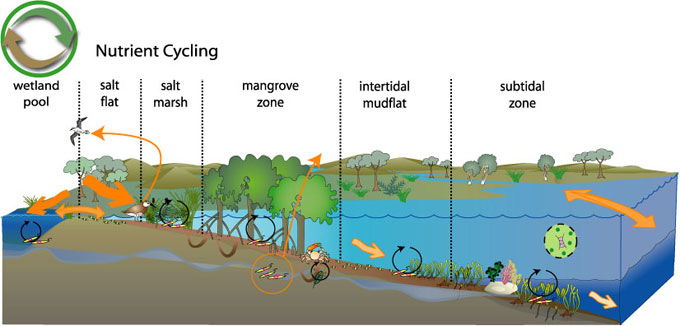
| Nutrients enter estuarine wetlands from neaby terrestrial areas dissolved in run-off or as particles of detritus | Wetland pools exchange nutrients with other estuarine ecosystems when connected by water flow (such as run-off or high tides) (Sheaves et al, 2006) | ||
| Estuarine wetlands can act as sinks for nutrients by filtering run-off, thereby reducing the amount of nutrients entering sub-tidal zones. This process improves water quality and reduces the risk of eutrophication and algal blooms downstream. Flushing wetlands, however, may provide a source of nutrients to coastal waters (Alongi and McKinnon, 2005; Rassam et al, 2006) |  |
Crabs and other animals can transfer nutrients (often in the form of detritus) into and out of the sediment. (Pennifold and Davis, 2001; Thrush and Dayton, 2002) | |
 |
Nutrients are exchanged with terrestrial areas (inluding nearby coastal areas and other continents) through animal movement. (Sheaves et al, 2006) | Microbes recycle nutrients and exchange nitrogen with the atmosphere. (Dennison and Abal, 1999; Rassam et al, 2006) | |
 |
Groundwater and riparian vegetation can play a significant role in reducing nitrogen entering streams, protecting downstream water quality (Rassam et al, 2006) | Nutrients are exchanged upstream and downstream through water and animal movement | |
 |
Nutrient cycling occurs within and between zones |
References:
- Alongi D.M. and McKinnon A.D. 2005, The cycling and fate of terrestrially-derived sediments and nutrients in the coastal zone of the Great Barrier Reef shelf, Marine Pollution Bulletin, Volume 51, Issues 1-4, Pages 239-252.
- Dennison, W.C., Abal, E.G. 1999, Moreton Bay Study: A Scientific Basis for the Healthy Waterways Campaign, South East Queensland Regional Water Quality Management Strategy, Brisbane, 246p.
- Pennifold, M., Davis, J., 2001, Macrofauna and nutrient cycling in the Swan River Estuary, Western Australia: experimental results, Hydrological Processes, Vol 12 (13) p2537-2553.
- Rassam, et al 2006 [in press]
- Thrush, S.F., Dayton, P.K., 2002, Disturbance to marine benthic habitats by trawling and dredging: Implications for marine biodiversity, Annual Review of Ecology and Systematics, 33, p449-474.
- Sheaves, et al 2006 [in press]


